#Story of Seventh Day of Navratri
Text
Story of Devi Kaalratri - Navratri 7th Day | Gorgeous Aarti of Maa Kalratri
Story of Devi Kaalratri – Navratri 7th Day | Gorgeous Aarti of Maa Kalratri
Story of Devi Kaalratri, Navratri 7th Day, Gorgeous Aarti of Maa Kalratri, Story of Seventh Day of Navratri, Goddess Kaalratri, Maa Kaalratri Vrat Katha, Kaalratri Mantra, Is Kaal Ratri Auspicious.
Nine forms of Maa Durga are worshiped during Navratri. On the seventh day of worship, Kalratri is worshiped with full rituals. According to religion, the eyes of the mother are opened on this day.
In…
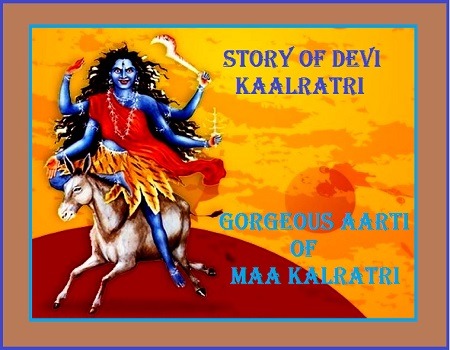
View On WordPress
#Goddess Kaalratri#Gorgeous Aarti of Maa Kalratri#Maa Kaalratri Vrat Katha#Navratri 7th Day#Story of Devi Kaalratri#Story of Seventh Day of Navratri
0 notes
Text
Naale baa.
This ia an urban legend that originated from Banglore, India. The legend of naale baa states of a witch that dates back to the 1990s, this witch is said to visit at night time, she knocks on one's door calling out to open the door.
This witch is also said to mimic the voices of the relatives of the people who's doors she knocks, but she is mostly said to mimic the voice of sweet woman. Her main goal is to lure men out of there houses.
It is said that if one ends up opening the door there will be found dead within the next 24 hours but she is mostly known to only kill men, more like eat them.
Stories say that the woman now known as the door knocking witch was once a normal young beautiful woman from that town, who was told to be the prettiest woman in all of the state, but on an unfortunate night a bunch of drunk men ganged up on her and did who knows what to/with her (I don't remember what there did coz I heard the story around 4 years ago)
And in the very end they killed her and from that day on she is said to seek revenge and justice, she is said to mostly be active in the ten days of dussehra (there are a bunch of different names of dussehra so please pick what you want call it- navratri, dashami, vijayadashami, durgashatmi)
Eitherways whatever you call it doesn't matter the reason she goes men-hunting on the holy festival days is because this festival is celebrated in the joy of the good's win over the bad.
The people of the town were worried because innocent men were also killed, so people came up with a solution and started writing 'naale baa' on there doors or the wall next to there doors. Naale baa means 'come tomorrow' which is why she would not go knocking around there doors.
A/n: And well that's it. I hope you all enjoyed the story, also I got no pictures sorry.
Also I'm not gonna be posting anything until after next week, so I guess the next post will be on the fourth or seventh of next month. Byeee all take care!!<3<3
2 notes
·
View notes
Text

Best Preschool in Electronic City
UP Square International Preschool
www.upsquareschools.in
Subject - Rama Navami
Ram Navami is celebrated to mark the birth of Lord Rama. According to the Hindu scriptures, Lord Rama is the seventh avatar of Lord Vishnu and was born on ninth day of Chaithra Navratri at Ayodhya, Uttar Pradesh.
Hence ,thishindu festival is a part of spring Navratri.
On this day, his devotees dress up like Lord Rama. Some dress up miniature statues of lord Rama and put in cradle. They also decorate their homes ,streets and offer pujas ,prayers and recite stories of Rama .
With Best Regards,
UP Square.
#RamNavami
#HappyRamNavami
#BestPreSchool
#UpSquareSchool
0 notes
Text
Top 5 differences between Chaitra Navratri and Sharad Navratri

Navratri, meaning"nine nights," is a vibrant Hindu festival that resonates across India. This festival is the time of great honor of Durga; the goddess represents strength, protection, and victory of good over evil. Though most readily associated with the grand autumnal celebration of Sharad Navratri, another equally important festival is that of Chaitra Navratri, celebrated during the spring season. United by the spirit of praying to Durga, still Sharad and Chaitra Navratri are poles apart in meaning, traditions, and ways of celebration.
Come along and take you through the journey of the two Navratris: Will be taking you through the two fascinating Navratris and revealing for you the differentiating features of each.
Differences Between Chaitra And Sharad Navratri
But while Chaitra Navratri and Sharad Navratri are both ways to honor the divine feminine, they're characterized by a few pretty definite differences. Here's a closer look at five points of difference.
1.Seasonal :
Chaitra Navratri: A springtime celebration (March-April) that coincides with nature's renewal and the beginning of the Hindu New Year in some regions. Imagine blossoming flowers and a sense of fresh beginnings filling the air as devotees honor Durga.
Sharad Navaratri: The autumnal (September-October) festival connected with the conclusion of the rainy season and a shift to cooler weather. To thank God for the harvest and the changing season to a more comfortable one.
2. Significance and Story:
Chaitra Navratri: These nine days resemble new beginnings and certainly welcome the springtime. This time in some parts is also to celebrate the birth of Lord Rama (Ram Navami). This really is the time of embracing new opportunities and welcoming a fresh cycle.
Sharad Navratri: the day when Goddess Durga killed the demon Mahishasura. This festival reminds us that even in the face of immense challenges, truth ultimately win.
3. Divine Focus:
Chaitra Navratri: The Navratri is dedicated to the nine forms of the goddess Durga. It gives a devotee an opportunity to get connected with the variety of aspects of the divine feminine, where each form represents another strength or quality.
Here are the 9 forms names :
Shailaputri (First Day)
Brahmacharini (Second Day)
Chandraghanta (Third Day)
Kushmanda (Fourth Day)
Skandamata (Fifth Day)
Katyayani (Sixth Day)
Kalaratri (Seventh Day)
Maha Gauri (Eighth Day)
Siddhidatri (Ninth Day)
Sharad Navratri: This festival celebrates nine nights with the nine forms of the Goddess Durga, symbolizing the nine forms of divine femininity. Devotees take blessings of the particular forms of Durga according to their personal requests and wishes, much similar to Chaitra Navratri.
4. Festive Flair:
Chaitra Navratri: Many people observe it in a relatively low profile of devotion, carrying out pujas (prayers), chanting mantras, and sometimes even going on fasts. Style of celebration may vary from one place to the other; however, generally, the same is relatively low keyed in nature so that a show of devotion can be made.
Sharad Navratri: A vibrant festival that involves grand pujas, colorful decorations, and regional dances (such as Garba/Dandiya Raas of Gujarat). These are the nine days when people meet and greet each other, represent their culture, and dance.
5. National Spotlight:
Chaitra Navratri: Generally, people following traditional Navratri are from Northern and Western India, with a less national profile than traditional Navrjsonth. The people undertaking fasting might also be less strict during Chaitra Navratri, as they might prefer undergoing partial fasting or not at all.
Sharad Navratri: Widely celebrated across India with immense national festival, connecting regional boundaries. Fasting is more commonly observed during Sharad Navratri, with some devotees following strict practices.
These features reflect the rich and manifold diversity of Hindu traditions. So, this involves the idea of different ways or modes of connecting to the divine feminine, celebrating the power of Durga, and lapping in the change of seasons every Navratri.
The Essence of Navratri
Chaitra Navratri and Sharad Navratri have the core resemblance to each other. These are the festival times that honor the divine femininity, similarities with the powerful Goddess Durga. It is that nine-day period when her devotees take the blessings they need for prosperity and fulfillment within the coming year.
Fasting, although not mandatory, is a very common practice seen during both Navratris. Some devotees go to the extent of observing very strict fasting, in which the person does not even take water, while some others to the veg diet or some food limitations, like eating only fruits and falahari vegetables. This practice is believed to clean the body and mind, providing spiritual growth. It also includes meditation and the chanting of mantras.
Meditation helps in making the mind calm and gives inner peace to the one doing so. On the other hand, the chanting of mantras helps the devotees get connected with the divine power of Durga. All these practices bring a place of spirituality and self-discovery.
During Navratri, if you're curious about what your future holds and want to understand your life better, our online horoscope service can help. We provide accurate daily horoscopes, online Kundali readings, and daily astrology insights to help you make the most of your day and plan your future. Now's the time to take a new step towards understanding yourself and your path in life better. Get in touch with us today to start making positive changes in your life.
#marriage astrologer#kundli predictions#daily astrology#astrology by date of birth#jyotish#accurate daily horoscopes#online horoscope#jaiminiastro
0 notes
Text
instagram
Ma Kaalratri is the seventh form of Goddess Durga and is worshipped on the seventh day of Navratri. She is the most ferocious avatar of Maa Durga and is believed to destroy all demon entities, ghosts, spirits, and negative energies. The story of Ma Kaalratri is that she was created to kill Chand-Munda and Raktabeej, and she destroyed evil-doers. She is also known for bringing peace back to the three worlds by killing Raktabeej. Ma Kaalratri blesses her devotees with siddhis and nidhis, namely knowledge, power, and wealth, and removes darkness and negativity from the lives of people. To worship the Goddess Kaalratri, devotees offer jaggery products or food made from jaggery as prasad to Maa Kaalratri and perform the puja on Saptami night.
#Kaalratri#GoddessKaalratri#NavratriDay7#DurgaPuja#DivineEnergy#SpiritualJourney#StrengthAndPower#NavratriBlessings#FierceGoddess#MahaGauri#DeviMaa#ED4WO#StudyAbroad#Instagram
0 notes
Text
Sri Sri Hanuman Mela Puja Materials and Preparations
Sri Sri Hanuman Mela is a vibrant and joyous festival celebrated with great enthusiasm to honor the mighty and revered deity, Lord Hanuman. This extravagant event takes place at different locations across India, attracting devotees, pilgrims, and tourists from far and wide. The festival showcases devotion, cultural performances, religious rituals, and a spiritual ambiance that fills the air with divine energy. Lord Hanuman holds immense significance in Hindu mythology and is revered for his unwavering devotion, immense strength, and devotion to Lord Rama, the seventh incarnation of Lord Vishnu. Hanuman is considered the epitome of courage, loyalty, and selfless service.
Devotees believe that worshiping Hanuman grants courage, protection from evils, and fulfillment of desires. Sri Sri Hanuman Mela serves as a platform for devotees to express their gratitude, seek blessings, and celebrate the presence of this beloved deity in their lives.
Sri Sri Hanuman Mela spans several days, often coinciding with important Hindu festivals like Hanuman Jayanti or during the auspicious period of Navratri. The festivities are marked by various activities to engage and inspire devotees, creating an atmosphere of joy and spiritual awakening.The festival grounds are adorned with decorative arches, colorful banners, and vibrant artwork depicting Lord Hanuman's heroic tales. Stalls selling devotional items, sweets, and handicrafts add to the festive ambiance.

Central to the Sri Sri Hanuman Mela are the elaborate worship rituals performed in honor of Lord Hanuman. Priestly rituals commence with the chanting of sacred mantras, invoking the presence and blessings of Lord Hanuman.Devotees offer fresh flowers, coconuts, vermilion, and garlands to the deity while reciting Hanuman Chalisa and other hymns dedicated to Lord Hanuman. Lighting of incense sticks and oil lamps creates a mesmerizing sight while spreading fragrance and illumination.
The festival is a platform to showcase the rich cultural heritage of India through various performances. Traditional dancers, musicians, and actors bring to life the tales of Lord Hanuman through vibrant dance dramas, folk music, and theatrical presentations.Devotional songs and bhajans praising Lord Hanuman fill the air, creating an atmosphere of spiritual ecstasy. Singers and musicians captivate the audience with their soul-stirring renditions, invoking devotion and deep connection with the divine.
Sri Sri Hanuman Mela Odia Puja Book Availble In Our Store
A highlight of Sri Sri Hanuman Mela is the grand processions featuring beautifully adorned chariots and palanquins carrying idols or statues of Lord Hanuman. Devotees enthusiastically participate, singing, dancing, and showering flower petals on the procession.In some regions, devotees dress like Hanuman and stage ritual enactments of Lord Hanuman's divine exploits, captivating the audience with their performance skills and dedication to the deity.
Sri Sri Hanuman Mela also serves as a platform for spiritual discourses by renowned scholars and saints who enlighten devotees with the teachings and stories associated with Hanuman. These discourses provide spiritual guidance, deepening the understanding of Hanuman's significance in one's life.Yoga sessions are often conducted during the festival, emphasizing the physical and mental well-being associated with a disciplined lifestyle. Practitioners engage in yoga and meditation sessions under the guidance of experienced teachers, promoting health and inner harmony.
Sri Sri Hanuman Mela encapsulates the devotion, faith, and love that devotees have for Lord Hanuman. This grand celebration unites people from different backgrounds, transcending cultural, social, and geographical boundaries.The festival reinforces the principles of courage, devotion, and selflessness. It instills a sense of gratitude, inspires service to humanity, and strengthens the bond with Lord Hanuman, who is believed to protect and guide his devotees.Sri Sri Hanuman Mela is not merely a festival; it is a spiritual journey filled with fervor, joy, and a deeper connection with the divine. The devotion and festivities experienced during this auspicious celebration leave an indelible mark on the hearts and minds of devotees, reminding them of Lord Hanuman's eternal presence and the significance of his teachings in their lives.
0 notes
Photo
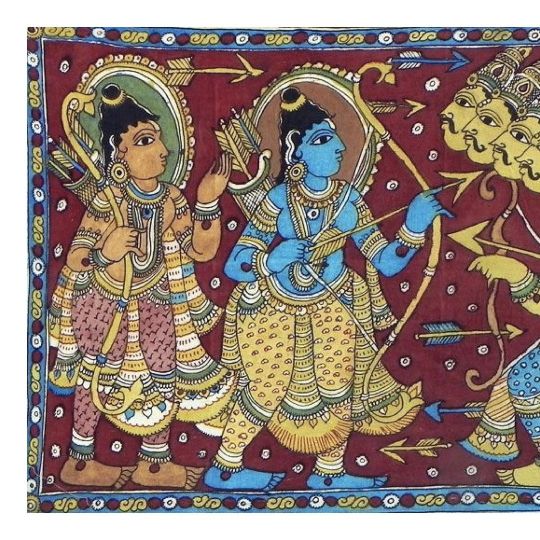
The Victory of Good over Evil Dussehra is also known as Vijayadashami in some regions of India. If we set aside the regional differences, the main events of this festival have one motto i.e. the victory of good over evil. Symbolizing the victory of good over evil, Dussehra is celebrated on the 10th day of the month of Ashvina (September–October), the seventh month of the Hindu calendar, with the appearance of the full moon, an event called the “bright fortnight” (shukla paksha). The festival symbolises the victory of Lord Rama over the demon King of Lanka, Ravana. Just like the story of Goddess Durga, the story of Rama also depicts the victory of good over evil. As a part of the celebration, people enact the story of Ramayana and the battle of Rama and Ravana in the form of skits and dramas. Rama Rama is one of the most widely worshipped Hindu deities, the embodiment of chivalry and virtue. The name is specifically associated with Ramachandra, the seventh incarnation (avatar) of Vishnu. His story is told in the epic poems the Mahabharata and the Ramayana. Ravana Ravana is the mythical multi-headed demon-king of Lanka in Hindu mythology. With ten heads and twenty arms, Ravana could change into any form he wished. Representing the very essence of evil, he famously fought and ultimately lost a series of epic battles against the hero Rama, seventh avatar of Vishnu. #dussehra #happydussehra #navratri #festival #durgapuja #india #diwali #indianfestival #celebration #dussehraspecial #festive #instagram #vijayadashami #festivals #ravan #dussehrawishes #ram #culture #photography #dussehrafestival #rlemployees #art #tirangadesigns #ravana #ethnicwear #instagood #festivevibes #festiveseason #padmarajkeshri #denim #india (at Bangalore, India) https://www.instagram.com/p/CjTJtJ2vNew/?igshid=NGJjMDIxMWI=
#dussehra#happydussehra#navratri#festival#durgapuja#india#diwali#indianfestival#celebration#dussehraspecial#festive#instagram#vijayadashami#festivals#ravan#dussehrawishes#ram#culture#photography#dussehrafestival#rlemployees#art#tirangadesigns#ravana#ethnicwear#instagood#festivevibes#festiveseason#padmarajkeshri#denim
0 notes
Photo
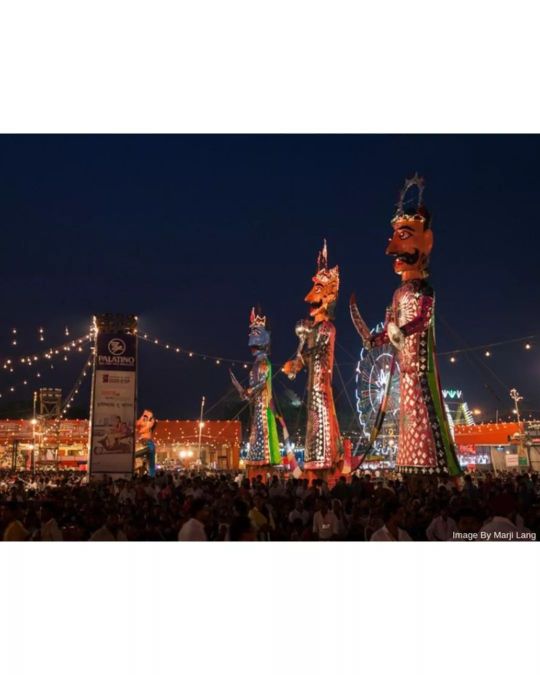
Dussehra Dussehra 2022: Dussehra or Vijayadashami will be celebrated on October 5 & 6 (Wednesday to Thursday) this year. All you want to know about the history and significance of the day. #Dussehra, also called Dasara or Vijayadashami, in Hinduism, holiday marking the triumph of Rama, an avatar of Vishnu, over the 10-headed demon king Ravana, who abducted Rama’s wife, Sita. The festival’s name is derived from the Sanskrit words dasha (“ten”) and hara (“defeat”). Symbolizing the victory of good over evil, Dussehra is celebrated on the 10th day of the month of Ashvina (September–October), the seventh month of the Hindu calendar, with the appearance of the full moon, an event called the “bright fortnight” (shukla paksha). Dussehra coincides with the culmination of the nine-day Navratri festival and with the tenth day of the Durga Puja festival. For many, it marks the beginning of preparation for Diwali, which occurs 20 days after Dussehra. Dussehra is celebrated with great fervour and fanfare. In North India, it incorporates Ram Lila, a gala theatrical enactment of Rama’s life story. Effigies of Ravana—often along with those of Meghnada (Ravana’s son) and Kumbhkarana (Ravana’s brother)—are stuffed with firecrackers and set ablaze at night in open fields. The term Dussehra is more common in North Indian states and Karnataka while the term Vijayadashami is more popular in West Bengal. In North India, Dussehra is celebrated with much fanfare and Ram Lila, an enactment of Lord Rama's story, is organized on all nine days of Navratri culminating with the killing of Ravana and burning of his life-size effigy on the day of Dussehra or Vijayadashami along with those of Meghnad and Kumbhakaran. Dusshehra also signifies getting rid of sins or bad qualities as each head of the Ravana symbolizes one bad quality. Worshipping Shami tree on the day of Vijayadashami holds a great significance in some parts of the country as it is believed that Arjun hid his weapons inside Shami tree during his exile. Shami Puja is also known as Banni Puja and Jammi puja in some of the southern states in India. #dussehra2022 #Spiritique #mystique #indianculture #folkindian #indianfolk https://www.instagram.com/p/CjDHar0JoWy/?igshid=NGJjMDIxMWI=
0 notes
Text
DAY 7 of NAVRATRI :-
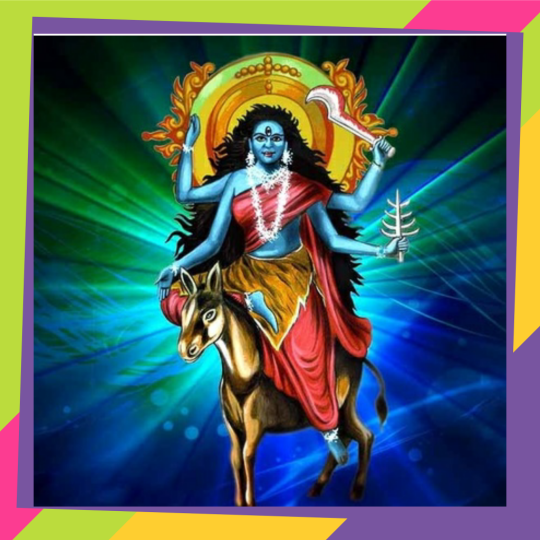
https://sanatancharacters.blogspot.com/2021/04/day-7-of-navratri-kalaratri-is-seventh.htmlhttps://sanatancharacters.blogspot.com/2021/04/day-7-of-navratri-kalaratri-is-seventh.htmlKalaratri Deviis the seventh aspect of the Hindu Goddess Durga and is the seventh Navadurga. Kalaratri Devi is considered as one of the most destructive form of Maa Durga. She is believed to be the destroyer of all demons, ghosts, evil spirits and negative energies.
She is also known as Shubhamkari, Kali, Bhadrakali and Mahakali which means auspicious or doing good in Sanskrit. She is believed to shower auspicious results to her devotees making them fearless. Read more -
@bharatuntoldstory@hindu @hindutva @bharatuntoldstory@hindu @hindutva
4 notes
·
View notes
Photo



Rama Navami is the day on which Lord Rama, the seventh incarnation of Lord Vishnu, incarnated in human form in the land of Ayodhya. He is the ardha ansh of Vishnu or has half the divinitive qualities of Lord Vishnu. The word “Rama” literally means one who is divinely blissful and who gives joy to others, and one in whom the sages rejoice.
Rama Navami is a spring Hindu festival that celebrates the birthday of the Hindu God Lord Rama. He is particularly important to the Vaishnavism tradition of Hinduism, as the seventh avatar of God Vishnu.
The festival celebrates the descent of Vishnu as Shri Rama avatar, through his birth to King Dasharatha and Queen Kausalya in Ayodhya. The festival is a part of the spring Navratri, and falls on the ninth day of the bright half (Shukla Paksha) in the Hindu calendar month of Chaitra. This typically occurs in the Gregorian months of March or April every year.
The day is marked by Rama Katha recitals, or reading of Rama stories including the Hindu sacred epic Ramayana. Some Vaishnava Hindus visit a temple, others pray within their home, and some participate in a bhajan or kirtan with music as a part of puja and aarti. Some devotees mark the event by taking miniature statues of the infant Rama, washing it and clothing it, then placing it in a cradle. Charitable events and community meals are also organized. The festival is an occasion for moral reflection for many Hindus. Some mark this day by vrata (fasting).
The important celebrations on this day take place at Ayodhya and Sita Samahit Sthal (Uttar Pradesh), Sitamarhi (Bihar), Janakpurdham (Nepal), Bhadrachalam (Telangana), Kodandarama Temple, Vontimitta (Andhra Pradesh) and Rameswaram (Tamil Nadu). Rathayatras, the chariot processions, also known as Shobha yatras of Rama, Sita, his brother Lakshmana and Hanuman, are taken out at several places. In Ayodhya, many take a dip in the sacred river Sarayu and then visit the Rama temple.
Significance of Ram Navami
The story of the Ramayan is a classic, eternal, universal message of Dharma versus adharma, of deva versus demon, of good versus evil, as represented in the battle between Rama and Ravana.
Ravana was a brahmin; he was a great scholar who wrote numerous works on scriptural philosophy. He was powerful, dynamic, and beautiful in appearance. As the brilliant, handsome king of Lanka, he had everything one would need to be happy and peaceful. Yet, he was arrogant, egoistic, greedy and lustful. His insatiable desires led him to crave more and more power, more and more money, and more and more ladies to fulfill his every whim.
There is one main difference: Bhagwan Rama’s heart overflowed with divinity, love, generosity, humility, and a sense of duty. Ravana’s heart, in contrast, was filled with avarice, hatred, and egoism. Under Bhagwan Rama’s divine touch, the animals became his devotees and his divine helpers. Under Ravana’s touch, even humans became animals.
Through his noble and divine choices, he teaches the world to choose dharma over Artha (when he leaves for the forest rather than be coronated as King) and to choose Moksha over Kama (when he chooses his kingdom over his marriage).
Bhagwan Rama teaches that :
As a sonRespectfully and lovingly obey your father’s orders. Sacrifice your own comfort for your father’s dignity.As a step-sonEven when your step mother (or mother-in-law) is not kind to you, even when she clearly dis- criminates against you in favor of her own birth child, do not resent her, do not fight against her. Respect her and her wishes.As a brotherRemain loyal to your brother. Care for him.As a husbandProtect your wife. Fight for her protection and her purity. But there are times when one’s divine path must even take precedence over the path of householder. Do not keep the role of householder as the ultimate role.As a KingSacrifice everything for your people. Do not worry about your own comfort, your own convenience or your own pleasure. Be willing to put the kingdom ahead of your own needs.
Ravana’s ego led to his own demise, first the demise of his spirit and heart and then the demise of his body. He thought he was the one who ran everything. He thought that he was the “doer” of it all. On the other hand, Bhagwan Rama was always humble, and he never took credit for anything. At the end of the war in Lanka, Bhagwan Rama was giving Sitaji a tour of the city, showing her where all of the various events had occurred. When, they reached the place where he victoriously slew Ravana, he reported it to Sitaji only as, “and this is where Ravana died.” He didn’t say, “This is where I crushed the demon,” or “This is where I killed Ravana.”
Ram Navami is a festival that celebrates the birth of Lord Rama, the son of King Dasharath. It was a joyous occasion in Ayodhya all those centuries ago when King Dasharath's heir was finally born. It was like a dream come true for the king as the lack of an heir had troubled him sorely for many years.
Lord Rama is an Avatar of Lord Vishnu who came down to earth to battle the invincible Ravana in human form. Lord Brahma had been receiving complaints from all the gods about the havoc that Ravana was wreaking on earth, but because Lord Brahma had granted Ravana so many boons, he could not be killed by a god. But Ravana had become so overconfident that he would never expect an attack from a human being. So Lord Vishnu agreed to go to earth in the guise of Prince Ram, the son of King Dasharath and Queen Kaushalya.
The story of Lord Rama as told in the great epic Ramayana is one that most Indians know irrespective of caste, creed and religion. Lord Rama is a legendary figure, the epitome of all that is good and true, the man who vanquished the demon king, Ravana. Lord Rama is not just a hero, but has been given the status of a god by the Hindus. Therefore, it comes as no surprise that his birth is celebrated year after year with great pomp and enjoyment on the ninth day after the new moon in Sukul Paksh (the waxing moon), which falls sometime in the month of April.
35 notes
·
View notes
Text
Happy 8-year period anniversary to me
Extra Judgemental people and those who think that blood and pain is masculine thing, please don't read further
It was 1st day of Navratri( like today is) i was gonna be in seventh grade soon(one exam away and just one class away from reading 8th grade science's 8th chapter) and i had my first period.(introductory shot)
My first reaction was, since at that time Salman Khan started hosting bigg boss and i had this huge crush on him, so i thought that i'm gonna have his baby..... (i was a big daily soap freak and they never showed the true process and netflix was unavailable too)but then my mother told me this is gonna happen till you reach the age of 45-50.she forgot to mention 7 days every month. (interval, suspense which is not gonna revealed till the end)
But finally i got to know why sanitary napkins are used, before that, i used think they are used by ladies who couldn't control their pee.
Also navratri being only time when i was prioritised over my brother, used to earn shitload of money for my gullak as i used to be a champion कन्या ( sometimes ate in 60 homes in single day,that to, when i'm being humble).
After that day my mother denied me of my biannual feast cum job and from next year nobody bothered to call me. They used to invite my sister right away(On my face). She tookover my legacy, also "why Vinita didn't came that one year", i finally knew. (climax)
So 8 long years of myths,ruined sheets at 3 a.m., those creepy whisper ads,black polythenes,what not and still not getting the due credit for enduring such pains and being labelled as weak, it hurts people(mesaage)
What's s point of all this
No i m not a feminist nor watching orange is the new black has suddenly made me so open abt all these ideas but,
Since past few days, suddenly girls on instagram have all turned feminists and are talking about uplifting other girls(total 10,precisely) by giving up on their Right to bitching(not gonna talk abt that genius idea getting viral now, u all probably know already).
So If u are doing it for real, then do it properly and share something which literally comes frm ur heart bitches! (no offense, in a friendliest way) for which we all could say "yeah behen! SAME PINCH".
Thankyou ujjawal, aditi and priyanka for tagging me but i dont knw how to tag people in my story so another reason for not taking up ur challenge.
15 notes
·
View notes
Text
Avatars of Shakti
Chaitra Navratri: Siddhidatri

On the ninth and last day of Chaita Navratri, Shakti is worshipped in the form of Siddhidatri (Siddhi=perfection, Datri=giver). In iconography, She is depicted with four arms and holds a lotus, conch, gada (mace), and chakra, and She sits on top of a lotus flower. She governs the planetary body Ketu, which is the southern lunar node.
This form of Shakti is worshiped by not only humans but also the other Gods. Her worship by Shiva is mentioned in Scripture, as related by Baba Rampuri:
When the Universal Mother was gripped with the idea of projecting Creation, She, first of all, created Lord Shiva who prayed to Her to endow him with perfections. For this purpose, the Universal Mother (Durgaa) produced Goddess Siddhidaatri from Her own person. As the behest of the Universal Mother, Goddess Siddidaatri bestowed eighteen kinds of rare perfections and powers and potentialities (Siddhis) on Lord Shiva. By virtue of these siddhis, Lord Shiva happened to develop a divine splendor.
Having acquired the siddhis from Goddess Siddhidaatri, Lord Shiva created Lord Vishnu who in turn created Lord Brahma who was entrusted with the task of the Creation whereas Lord Vishnu got the task of Protection and Lord Shiva that of Destruction.
Lord Brahma felt a great difficulty in his task of the Creation in the absence of man and woman. Thereupon he remembered Mother Siddhidaatri. When she appeared before him, Lord Brahma said to her, “Oh Great Mother! I cannot carry on with the task of the Creation in the absence of man and woman. You kindly solve this problem of mine through your supernatural attainments (siddhis).”
Having heard Lord Brahma, Mother Siddidaatri converted half the person of Lord Shiva into a woman. Thus Lord Shiva became half-male and half-female and came to be known as Ardhanaarishwara. Thus the problem of Lord Brahma was resolved and the task of the Creation went on smoothly.
Her mantra is:
Sidhha Gandharvay khshadher Surair Marair Api
Sevya Mana Sada Bhooyat Siddhida Siddhidayini
Which in English means:
Goddess Siddhidatri who is worshipped by Siddha, Gandharva, Yaksh, Gods, Demons etc., holds Conch, Chakra, Gada and Lotus in her hands, giver of all siddhis and victory all over, be propitious to me.
For purposes of pronunciation, I have included a link to the spoken mantra (The mantra itself lasts for the first minute of this video, after which a speaker gives a lecture in Hindi).
Chaitra Navratri: Mahagauri
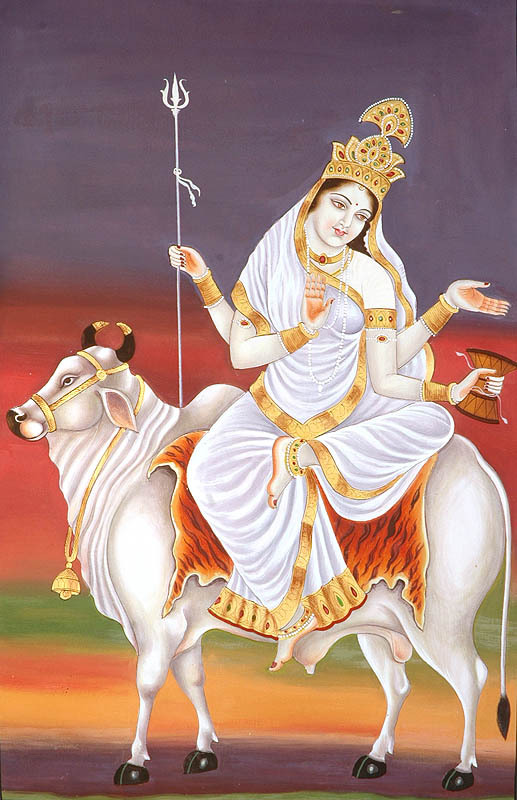
On the eighth day of Chaitra Navratri, Shakti is worshipped in the form of Mahagauri (Mahagauri=extremely white). She has four arms. In Her upper right hand She holds a trishul (trident) and in Her lower left hand She carries a Damaru (small, two-headed drum). Her upper left hand is in the Varada Mudra position, and Her lower right hand forms the Abhaya Mudra. She rides atop a white bull and rules the planetary body Rahu (In Vedic astrology, Rahu is the northern node of the Moon). The following origin of this form in mythology is related by Yogi Ananda Saraswathi:
She observed severe penance as Goddess Parvati to get earn Lord Siva as her husband. Once, Lord Shiva was rude to her by pointing out her dark complexion. She started observing hard penance. This went on for over a thousand years. During this period her body got covered with soil. It became darker than ever. Then one day when Lord Shiva came looking for Mother. He was pleased with her penance. Thereafter he took Maa to the Ganges and bathed her lovingly. Mother regained her beauty with pure complexion and earned the name Maha Gauri.
In this form Mahagauri represents purity and austerity. She scours and scrubs the filth from the souls of Her devotees and purifies their hearts. Both married and unmarried women especially worship Her on this day, as She is said to guide unmarried women in finding a good husband and She blesses married women with peaceful and harmonious marital lives.
Kumari Puja during Ashtami Puja celebrations also occurs on the eighth day of Chaitra Navratri, as related by this passage from astrosage.com:
On the sacred occasion of Ashtami Pooja, Kanya Poojan (feeding of little girls) are also done to please Goddesses of Navdurga (nine forms of Durga). Nine little girls are invited at home of worshippers and are fed varieties of delicious sweet dishes. Devotees pay the best homage to nine little girls considering them nine forms of Navdurga. This ritual accomplishes their Pooja and gives blessings of Nav Durga.
Her mantra is:
Shwete Vrishe Maha Rudha Shwetambardhara Shuchih
Maha Gauri Subham Dadhyanmahadev Pramodada
Which means in English:
Goddess Mahagauri who rides on white bull, wear pure white clothes, giver of happiness, be propitious to me.
For purposes of pronunciation, I have included a link to the spoken mantra (The mantra itself lasts for the first 35 seconds of this video, after which a speaker gives a lecture in Hindi).
Chaitra Navratri: Kalaratri

On the seventh day of Chaitra Navratri, Shakti is worshipped in the form of Kalaratri (Kala=time, black in reference to the primal darkness before the Creation, Ratri=night). Kalaratri is a form of Kali. She is dark in complexion and rides atop a donkey. She is depicted with four arms, Her right hands positioned in Abhaya and Varada mudras and Her left hands holding a sickle and a thorn-like iron weapon. In mythology, She slayed the dreadful demon Raktabeej, as Miss Saxena relates:
In this form Goddess Kalratri killed Raktabeej. Raktabeej was a demon who could multiply from every drop of his blood which fell on the ground. The Goddess Kaalratri killed him by licking the blood before it could reach the ground and hence conquered him.
Kalaratri’s form is dreadful and repulsive in appearance (She is the most misunderstood of the Hindu Goddesses by many Westerners!), but She is very protective of Her devotees and protects them against the evil spiritual influences of demons and dark forces. While She has a ferocious side, She also has a very maternal side. She also aids Her devotees to rid their lives of tamasic qualities, effectively destroying ignorance. She governs the planet Saturn and is associated with the Sahasrara (thousand, infinite) chakra, which is located on the crown of the head. It is the chakra of Pure Light and of Supreme Consciousness. Awakening the Sahasrara chakra leads to ultimate spiritual enlightenment.
Her mantra is:
Ekveni Japakarnapura Nagna Kharastitha
Lamboshthi Karnikakarni Tailabhyakta Sharirani
Vaampadolla Salloh Lata Kanthak Bhushna
Vardhan Murdha Dhvaja Krishna Kalratri Bhayankari
Which means in English:
She is naked, rides on an donkey, has a long tongue, lustrous body, wears ornaments on her legs like lightning, is black in color, has unlocked hair, big eyes and ears and is very dangerous looking. Meditating on this form of Kalratri removes all obstacles as well as removes all magical effects created by others.
For purposes of pronunciation, I have included a link to the spoken mantra (The mantra itself lasts for the first minute of this video, after which a speaker gives a lecture in Hindi).
Chaitra Navratri: Katyayani
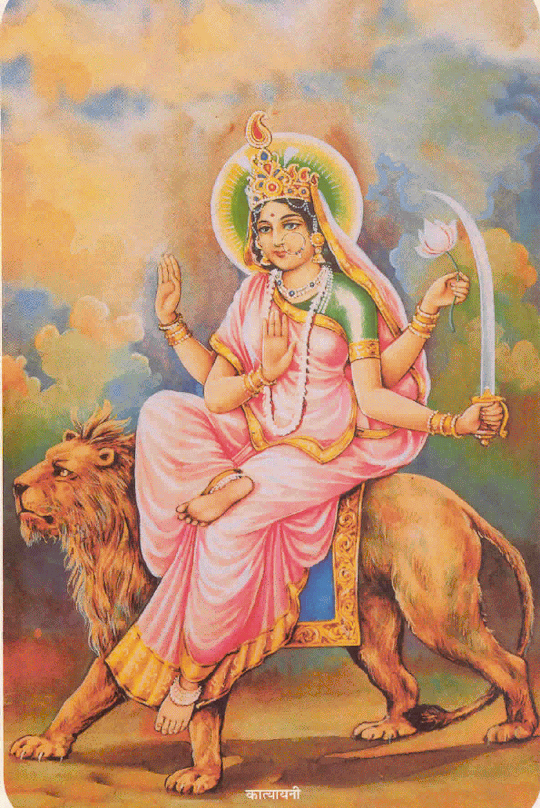
On the sixth day of Chaitra Navratri, Shakti is worshipped in the form of Katyayani. The story behind her name’s origin is related by Mr. Subhamoy Das in the following passage:
The legend behind her name goes thus: Once upon a time, there was a great sage called Kata, who had a son named Katya. Kata was very famous and renowned in the lineage of saints. He underwent long austerities and penance in order to receive the grace of the Mother Goddess. He wished to have a daughter in the form of a goddess. According to his wish and desire the Mother Goddess granted his request. Katyayani was born to Kata as an avatar of Durga.
Katyayani rides atop a majestic lion and is (typically) depicted with four arms. In Her left hands She holds a sword and a lotus flower (symbolising blooming above the murk to achieve enlightenment); Her right hands are positioned in Abhaya( indicates for the devotee not to fear and is a symbol of protection) and Varada (symbolises the giving of blessings) mudras. In the Vamana Purana, She is depicted in Her fiercest form during the battle with the demon Mahishasura, whom She slays.
Katyayani rules over the planet Jupiter. Her chakra is the most important of all chakras: the Ajna (command, knowledge, wisdom) chakra, or Third Eye. This is where the bridge between our human potential crosses into Divine Consciousness. Hindus also believe that spiritual energy from the outside world enters the conscious via this gateway chakra, and so they take great care in protecting this chakra through religious markings (made with holy ash, vermillion, etc.) on the third eye.
a lady’s marriage is experiencing any delays Katyayani is often worshipped in order to remove the obstacles that are preventing the marriage from taking place.
Her mantra is:
Chandrahaasojjval Karaa Shaardoolvarvaahanaa
Katyayani Shubham Dadyaad Devi Daanavghatini
Which in English means:
Devi Katyayani, who holds Chandrahaas Sword and other weapons in her ten hands, rides on Lion, and destroying demons, be propitious to me.
(Note: She is most commonly depicted with four hands, but some Images do depict Her with eight, ten, and even eighteen hands!)
For purposes of pronunciation, I have included a link to the spoken mantra (The mantra itself lasts for the first 35 seconds of this video, after which a speaker gives a lecture in Hindi).
Chaitra Navratri: Kushmanda
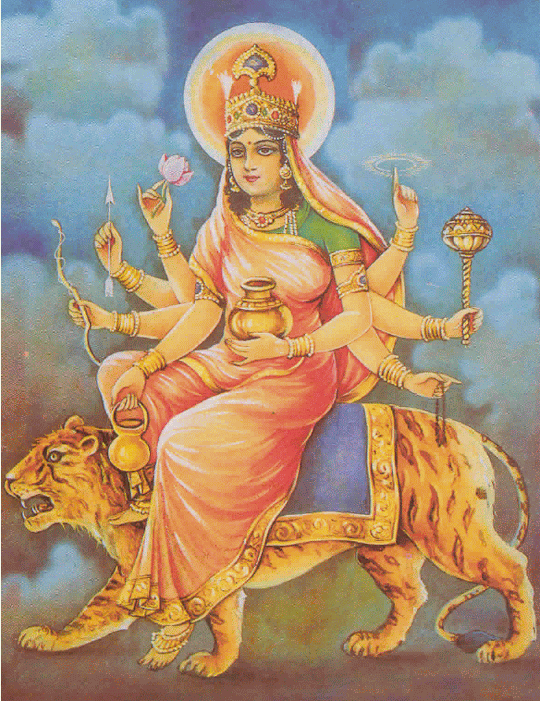
On the fourth day of Chaitra Navratri, Shakti is worshipped in the form of Kushmanda (Ku=little, ushma=warmth, anda=egg). Symbolically, Her name means “that is from whose fraction of warmth the universe has been emanated,” designating Her as the comic egg which created the Universe and hence a Creator Goddess. Parvati takes on the form of Kushmanda after She started living inside the core of the Sun to liberate energy to the rest of the Universe. As a solar Goddess, Her governing planetary body is the Sun. This goes back to Her role as a Creator, for in the beginning the Universe was nothing more but a void of darkness until Her light spread in all directions. Her mount is a lion and She is depicted with eight arms in iconography. She holds a kamandal (an oblong water pot carried by ascetics), dhanush (bow), arrow, and lotus flower (symbolising blooming above the murk to achieve enlightenment) in Her right hands, and in Her left hands She carries a kalasha (a metal pot with a large base and small mouth), Japa mala beads (prayer beads), gada (a blunt mace/club), and a chakra (a disc-like weapon). Kushmanda bestows brightness, clarity, and peace upon Her worshippers.
She is associated with the Anahata Chakra (anahata=unstruck, unhurt in Sanskrit, implying that beneath all the pain in our heart, universal love and compassion is our core nature that is still intact even though we may believe it is damaged), which is the seat of love located in the heart. Love does not only refer to the popular sense of the word, however, but also to the deep, compassionate, Divine love. In a beautiful description of the Anahata chakra, a writer on chakras.net writes:
The Anāhata Chakra is our inner temple in which the divine Ātmā, “the flame of life”, resides. Self-Realisation, also known as God-Realisation, involves the recognition of our own Self, the Ātmā. To show that something belongs to us or concerns us we spontaneously point to the centre of the chest, the site of the Anāhata Chakra. No-one points to the head, the stomach or any other part of the body. This shows clearly that we spontaneously identify ourselves with the Ātmā within the heart centre. In the Chandogya Upanishad it is written:
“In the centre of the body there is a little shrine surrounded by a wall with eleven doors. Hidden within the shrine a Lotus blossoms, and within this there is a tiny, little room.”
What does this tiny room in the heart of the Lotus mean? It is the Ātmā, our true Self. The Ātmā is a part of God. It is pure, unchanging, Infinite Consciousness. It is Eternal, Unborn and Immortal, and exists in every living being. Just as the whole tree is already contained and present within a seed, the essence of the entire cosmos exists in the centre of the Heart Chakra.
Her mantra is:
Sura Sampurna Kalasham Rudhira Plutmev Cha
Dadhana Hastpad Mabhyam Kushmanda Shubh Dastu Me
Which means in English:
May the Goddess Kushmanda who holds two pitchers full of madira and blood in her lotus hands, be propitious to me. (I believe the word ‘madira’ is in reference to amrita, the nectar of immortality. Corrections for the meaning of this mantra, as well as further explanations regarding its meaning, are very welcome!)
For purposes of pronunciation, I have included a link to the spoken mantra (The mantra itself lasts for the first 35 seconds of this video, after which a speaker gives a lecture in Hindi).
7 notes
·
View notes
Photo
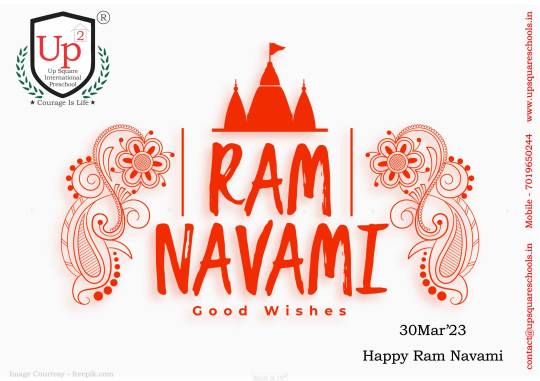
Best Preschool in Electronic City
UP Square International Preschool
www.upsquareschools.in
Subject - Rama Navami
Ram Navami is celebrated to mark the birth of Lord Rama. According to the Hindu scriptures, Lord Rama is the seventh avatar of Lord Vishnu and was born on ninth day of Chaithra Navratri at Ayodhya, Uttar Pradesh.
Hence ,thishindu festival is a part of spring Navratri.
On this day, his devotees dress up like Lord Rama. Some dress up miniature statues of lord Rama and put in cradle. They also decorate their homes ,streets and offer pujas ,prayers and recite stories of Rama .
With Best Regards,
UP Square.
0 notes
Link

Ram Navami (Ram Navami) Is a Hindu Festival Celebrating The Birthday Of Lord Ram Lord To The King Of Ayodhya Dasaratha.
The Celebration Is Held On The Ninth Day Of The Month Of Chaitra (The First Month Of The Indian Lunar Calendar). It Marks The Climax Of The Spring Festival Of Vasanta Navratri (Chaitra Navratri) Which Started From Gudi Padwa Or Ugadi.
Rama Is The Seventh Incarnation Of Vishnu. He Is The Hero Of The Ancient Sanskrit Epic Ramayana.
Before The Celebration, The Book Was Read Continuously In The Month Of Chaitra. In Ram Navami Itself, The Highlight Of The Story Can Be Seen In The Temple.
The Houses On Rama Navami Have Been Thoroughly Cleaned, And The Family Shrine May Be Decorated With Small Statues Of Rama. The Offerings Of Flowers And Fruits Are Placed On The God Rine, And Pray And Pray After Bathing Early.
You Can visit our website for more details About Ram Navami Wishes Quotes Messages Images Greeting
0 notes
Link
नवरात्र के सातवें दिन नवदुर्गा के सप्तम रूप माँ कालरात्रि की पूजा करने का विधान हैं। माँ कालरात्रि का रूप अंधकार के समान एक दम काला तथा भयानक हैं जिनकी उत्पत्ति पापियों का नाश करने के उद्देश्य से हुई थी। माँ कालरात्रि की पूजा करने से भक्तों को रात्रि का भय, अंधकार का भय तथा ग्रहों के दोष से मुक्ति मिलती हैं। जहाँ एक ओर माँ पापियों का नाश करने वाली तो दूसरी ओर भक्तों को अभय देने वाली हैं। आइए माँ कालरात्रि के बारे में जानते हैं।
0 notes
Photo
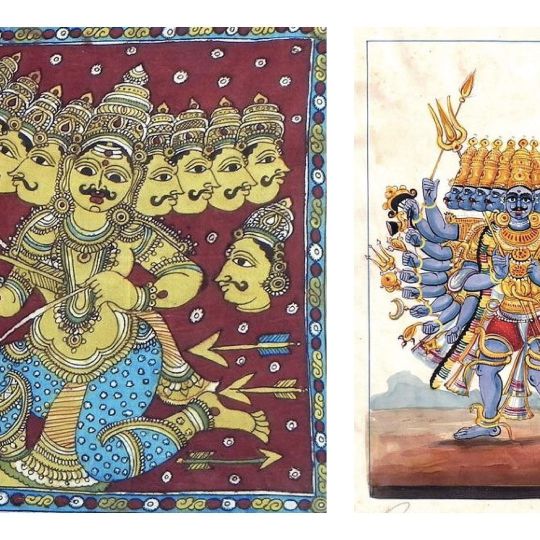
The Victory of Good over Evil Dussehra is also known as Vijayadashami in some regions of India. If we set aside the regional differences, the main events of this festival have one motto i.e. the victory of good over evil. Symbolizing the victory of good over evil, Dussehra is celebrated on the 10th day of the month of Ashvina (September–October), the seventh month of the Hindu calendar, with the appearance of the full moon, an event called the “bright fortnight” (shukla paksha). The festival symbolises the victory of Lord Rama over the demon King of Lanka, Ravana. Just like the story of Goddess Durga, the story of Rama also depicts the victory of good over evil. As a part of the celebration, people enact the story of Ramayana and the battle of Rama and Ravana in the form of skits and dramas. Rama Rama is one of the most widely worshipped Hindu deities, the embodiment of chivalry and virtue. The name is specifically associated with Ramachandra, the seventh incarnation (avatar) of Vishnu. His story is told in the epic poems the Mahabharata and the Ramayana. Ravana Ravana is the mythical multi-headed demon-king of Lanka in Hindu mythology. With ten heads and twenty arms, Ravana could change into any form he wished. Representing the very essence of evil, he famously fought and ultimately lost a series of epic battles against the hero Rama, seventh avatar of Vishnu. #dussehra #happydussehra #navratri #festival #durgapuja #india #diwali #indianfestival #celebration #dussehraspecial #festive #instagram #vijayadashami #festivals #ravan #dussehrawishes #ram #culture #photography #dussehrafestival #rlemployees #art #tirangadesigns #ravana #ethnicwear #instagood #festivevibes #festiveseason #padmarajkeshri #denim #india (at Bangalore, India) https://www.instagram.com/p/CjTJqf_Ptvg/?igshid=NGJjMDIxMWI=
#dussehra#happydussehra#navratri#festival#durgapuja#india#diwali#indianfestival#celebration#dussehraspecial#festive#instagram#vijayadashami#festivals#ravan#dussehrawishes#ram#culture#photography#dussehrafestival#rlemployees#art#tirangadesigns#ravana#ethnicwear#instagood#festivevibes#festiveseason#padmarajkeshri#denim
0 notes